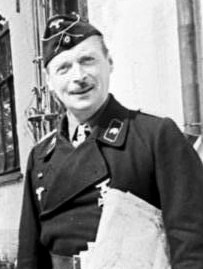
Back Hyazinth Strachwitz von Gross-Zauche und Camminetz AN فون شتراخفيتس Arabic فون ستراشفيتز ARZ Хиацинт Граф Щрахвиц фон Грос-Цаухе унд Каминец Bulgarian Hyazinth Graf Strachwitz Breton Hyazinth Graf Strachwitz von Gross-Zauche und Camminetz Catalan Hyazinth Graf Strachwitz Czech Hyazinth Graf Strachwitz German Hyazinth von Strachwitz Estonian هیاتسینت گراف اشتراخویتس Persian
Hyazinth Graf Strachwitz | |
|---|---|
 Strachwitz in June 1943 | |
| Nickname(s) | Der Panzergraf |
| Born | 30 July 1893 Groß Stein, Province of Silesia, Kingdom of Prussia, German Empirenow Kamień Śląski, Opole Voivodeship, Poland |
| Died | 25 April 1968 (aged 74) Trostberg, Bavaria, West Germany[1] |
| Buried | Cemetery in Grabenstätt |
| Service/ | Prussian Army German Army (1935–1945) |
| Years of service | 1912–45 |
| Rank | Generalleutnant of the Reserves SS-Standartenführer |
| Service number | Nazi Party 1,405,562 SS 82,857 |
| Unit | Guards Cavalry Division Freikorps "von Hülsen" 1st Panzer Division |
| Commands held | Panzer-Regiment "Großdeutschland" of the Grossdeutschland Division |
| Battles/wars | See battles |
| Awards | Knight's Cross with Oak Leaves, Swords and Diamonds |
| Other work | land owner and farmer, military advisor |
Hyazinth Graf Strachwitz (also known as Hyazinth Graf Strachwitz von Groß-Zauche und Camminetz) (30 July 1893 – 25 April 1968) was a German officer of aristocratic descent in the Wehrmacht during World War II. He was a recipient of the Knight's Cross of the Iron Cross with Oak Leaves, Swords and Diamonds.
Strachwitz was born in 1893 on his family estate in Silesia. He was educated at various Prussian military academies and served in World War I, during which he was taken prisoner by French forces in October 1914. He made numerous failed attempts to escape custody while held prisoner.
He returned to Germany after the war in 1918. He joined the Freikorps and fought against the Spartacist uprising of the German Revolution in Berlin; he later fought Polish forces in the Silesian Uprisings. In the mid-1920s he took over the family estate from his father; he later became a member of the Nazi Party and the Allgemeine-SS.
Strachwitz participated in the Invasion of Poland in 1939 and in the Battle of France in 1940. Transferred to the 16th Panzer Division he fought in the Invasion of Yugoslavia and Operation Barbarossa, the German invasion of the Soviet Union. He was a recipient of the Knight's Cross of the Iron Cross with Oak Leaves for the Battle of Kalach in the summer of 1942. He received the Swords to his Knight's Cross for his actions in the Third Battle of Kharkov. He then fought in the Battle of Kursk and the German retreat to the Dnieper. While commanding a battle group in the Battle of Narva in early 1944 he was awarded the Diamonds to his Knight's Cross on 15 April. In 1945, he surrendered to US forces and was released in 1947. He died in 1968 and was buried with full military honours.
- ^ Von Ehrenkrook 2000, p. 497.
© MMXXIII Rich X Search. We shall prevail. All rights reserved. Rich X Search